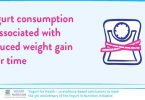A comprehensive review from Mozaffarian summarizes recent evidence for health effects of the diet on cardiometabolic diseases, including obesity. The author highlights the importance of focusing on food and overall diet pattern, rather than isolated nutrients. Besides, it recognizes the complex influences of different foods on long-term weight regulation, rather than simply counting calories.
Increased intake of yogurt and some other foods
According to the author, key diet-related priorities to protect against chronic weight gain and reduce adiposity are: increasing intakes of fruits, vegetables, nuts, yogurt, fish, vegetable oils and whole grains; reduce consumption of refined grains, starches, sugars and meats; sleeping at least 7 to 8 hours nightly. More research need to be done to elucidate the impact of other lifestyle factors, like TV watching, altered circadian rhythms and sleep duration, and possibly maternal-fetal (eg, placental) influences.
Dairy product represent a diverse class of foods and long-term effects may vary by the type of dairy. Yogurt appears protective against long-term weight gain, although when sugar-sweetened, approximately half the benefit appears lost. Animal-experimental studies and trials in humans suggest that probiotics and probiotic-microbiome interactions play a key role in the protective effects of yogurt against obesity.
Low-fat versus whole-fat
The review reports that dairy fat itself may promote cardiometabolic health. However, no evidence supports the superiority of low-fat dairy products for health, in particular for risk of obesity.





